#features of OOPs in java
Explore tagged Tumblr posts
Text
what are Features of OOPs in java
Introduction
A programming paradigm known as object-oriented programming, or OOP, use objects to represent concepts and real-world phenomena. The behaviors (methods) and attributes (data) of an object determine its functionality and state. OOP makes abstraction, modularity, and code reuse possible. Among the primary characteristics of Java's OOP are:
Class: A class is an outline or template that specifies the shared characteristics and operations of a collection of objects. To create many instances of an object with the same attributes and behaviors, use a class. For instance, a class called Car may include methods like start(), stop(), accelerate(), and others, as well as characteristics like color, model, and speed. Constructors are unique methods that set an object's initial state when it is created; they may also be found in classes.

OOP, or object-oriented programming, is a type of programming
Object: An object is a particular state and behavior of an instance of a class. An object has the ability to call its own methods, access, and edit its own properties. Additionally, an object may communicate with other objects by sending them messages or using their methods. For instance, the class Car may be used to construct an object with the name myCar and unique values for the properties color, model, speed, etc. The start(), stop(), accelerate(), and other methods specified in the class Car can also be called by the object myCar.
A class can inherit the properties and methods of another class using the technique of inheritance. The subclass, often known as the kid class, is the class that inherits, and the The superclass or parent class is the one from which an inheritance is derived. Polymorphism and code reusability are made possible by inheritance. For instance, a class called Truck can inherit from the class Car and have all of the methods and attributes of the Car class in addition to having unique properties and methods of its own. Class Car is a superclass of class Truck, while the class Truck is a subclass of class Car.
Polymorphism: The capacity of an item to assume several forms based on the situation is known as polymorphism. Dynamic binding—in which an object's type is decided at runtime as opposed to compile time—is made possible via polymorphism. Overloading and overriding methods can be used to produce polymorphism. Overloading a method is when a There are several methods in a class with the same name but distinct arguments. Redefining a method that was inherited from a superclass by a subclass is known as method overriding. For instance, the drive() method of the class Truck may require an argument called load, but the drive() method of the class Car may require no parameters at all. The drive() function of the class Car is being superseded by the class Truck. Calling myVehicle is necessary if it is specified as a Car object but is really allocated to a Truck.Drive() will call the class Truck's drive() function rather than the class Car's.
Abstraction: The technique of revealing only an object's core characteristics while concealing the implementation details is known as abstraction. Maintainability, modularity, and simplicity are made possible via abstraction. Distraction may be accomplished by utilizing interfaces and abstract classes. A class that lacks the ability to be created and may have one or more abstract methods that need to be implemented by the subclasses since they lack a body. A class can implement an interface, which is a group of abstract methods, to conform to a specific behavior. For instance, an interface called Electric may have an abstract method called charge() that is bodyless, and an abstract class named Vehicle may have an abstract method named drive() that is bodyless. It is possible for a class called Tesla to inherit from the class Vehicle, implement the Electric interface, and offer the drive() and charge() methods. A Tesla class object has access to theThe internal workings of the functions drive() and charge() are not disclosed.
to know more you can vist here analytics jobs
1 note
·
View note
Text
Very amused every time someone discovers the ultimate way to do OOP in its truest, most polymorphic, most object-oriented form and its just immutable classes with public instance variables and no methods and no inheritance being transformed through singleton classes with no instance variables and one side-effect-free method, potentially taking a function as a parameter or returning another single method class. Brother you just reinvented functional programming.
#codeblr#progblr#object oriented programming#OOP#functional programming#Algebraic data types. Pure functions. Higher order functions. Closures. The gangs all here#And then whenever you tell them that what they did. they say its like functional programming but different because its polymorphic#Literally had a conniption when robert martin said he discovered clojure was actually an oop language because#it was better at polymorphism than java#This is without knowing the subtype polymorphic features in clojure
4 notes
·
View notes
Text
o hi i use both of them! in particular rust is my favorite programming language
rust: fast like C/C++ but memory management doesnt suck unlike C/C++
If any Haskell and or Rust fans follow me, give me 1 good reason to learn them
#ultimately it depends on what you find convincing#rust is less popular than languages like C C++ and java so if you want a job then eh#if you don't need the performance of C then sticking to higher-level OOP languages like java is fine#notably rust lacks proper inheritance (though it does have other OOP features like polymorphism & encapsulation)#so if u use inheritance a lot then thats a reason to Not use rust#rust has a couple more specific language features that i really love so lmk if u want me to expand on them#as for haskell if ur not interested in functional programming then it's probably not worth it ngl#im a massive fuckin nerd so i like it but it definitely took a LOT of effort compared to any procedural language!
33 notes
·
View notes
Text
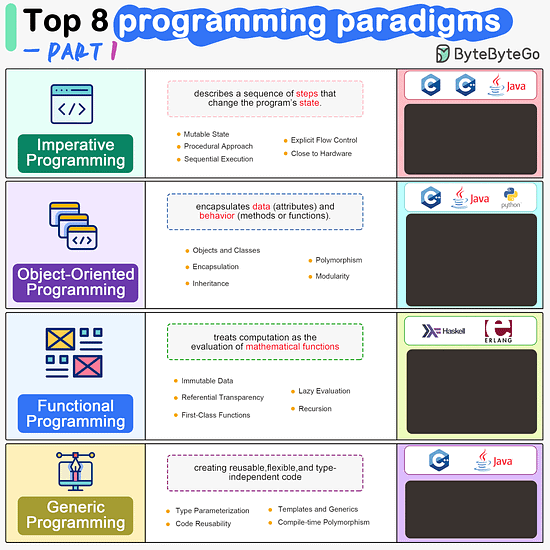
ByteByteGo | Newsletter/Blog
From the newsletter:
Imperative Programming Imperative programming describes a sequence of steps that change the program’s state. Languages like C, C++, Java, Python (to an extent), and many others support imperative programming styles.
Declarative Programming Declarative programming emphasizes expressing logic and functionalities without describing the control flow explicitly. Functional programming is a popular form of declarative programming.
Object-Oriented Programming (OOP) Object-oriented programming (OOP) revolves around the concept of objects, which encapsulate data (attributes) and behavior (methods or functions). Common object-oriented programming languages include Java, C++, Python, Ruby, and C#.
Aspect-Oriented Programming (AOP) Aspect-oriented programming (AOP) aims to modularize concerns that cut across multiple parts of a software system. AspectJ is one of the most well-known AOP frameworks that extends Java with AOP capabilities.
Functional Programming Functional Programming (FP) treats computation as the evaluation of mathematical functions and emphasizes the use of immutable data and declarative expressions. Languages like Haskell, Lisp, Erlang, and some features in languages like JavaScript, Python, and Scala support functional programming paradigms.
Reactive Programming Reactive Programming deals with asynchronous data streams and the propagation of changes. Event-driven applications, and streaming data processing applications benefit from reactive programming.
Generic Programming Generic Programming aims at creating reusable, flexible, and type-independent code by allowing algorithms and data structures to be written without specifying the types they will operate on. Generic programming is extensively used in libraries and frameworks to create data structures like lists, stacks, queues, and algorithms like sorting, searching.
Concurrent Programming Concurrent Programming deals with the execution of multiple tasks or processes simultaneously, improving performance and resource utilization. Concurrent programming is utilized in various applications, including multi-threaded servers, parallel processing, concurrent web servers, and high-performance computing.
#bytebytego#resource#programming#concurrent#generic#reactive#funtional#aspect#oriented#aop#fp#object#oop#declarative#imperative
8 notes
·
View notes
Text
Best IT Courses In Bhubaneswar:- seeree services pvt ltd.
Introduction:- seeree is one of the best IT training institute and Software industry, features completely Industrial training on Python , PHP , .NET , C Programming,Java , IOT , AI , GD PI , ORACLE and ALL CERTIFICATION COURSES as well as provides seminar,cultural activity and jobs
Courses we provided:- 1) Java Fullstack 2) Python Fullstack 3) PHP Fullstack 4) Preplacement Training & Sp. Eng 5) .NET Fulstack 6) SEO/Digital Marketing 7) SAP 8) MERN 9) Software Testing 10)Data Analyst 11)Data Science 12)Data Engineering 13)PGDCA 14)Tally 15)Graphics Design
Course1:- Java Fullstack

A Class in Java is where we teach objects how to behave. Education at seeree means way to success. The way of teaching by corporate trainers will bloom your career. We have the best java training classes in Bhubaneswar. 100% Placement Support. Job Support Post Training. This course will give you a firm foundation in Java, commonly used programming language. Java technology is wide used currently. Java is a programming language and it is a platform. Hardware or software environment in which a program runs, known as a platform. Since Java has its own Runtime Environment (JRE) and API, it is called platform. Java programming language is designed to meet the challenges of application development in the context of heterogeneous, network-wide distributed environment. Java is an object-oriented programming (OOP) language that uses many common elements from other OOP languages, such as C++. Java is a complete platform for software development. Java is suitable for enterprise large scale applications.]
Course2:- Python Fullstack

Seeree offers best python course in Bhubaneswar with 100% job assurance and low fee. Learn from real time corporate trainers and experienced faculties. Groom your personality with our faculty. Seeree helps to build confidence in students to give exposure to their skills to the company.
Python is dynamically typed , compiled and interpreted , procedural and object oriented , generalized , general-purpose , platform independent programming language. Python is a high-level, structured, open-source programming language that can be used for a wide variety of programming tasks.
Course3:- PHP Fullstack

seeree is the best training institute which provide PHP Training courses in bhubaneswar and all over odisha We aim the students to learn and grow altogether with the need of IT firms.
PHP is a server scripting language, and a powerful tool for making dynamic and interactive Web pages. PHP is a widely-used, free, and efficient alternative to competitors such as Microsoft's ASP.
Course4:- Preplacement Training & Sp. Eng

Welcome to SEEREE Institute, where excellence meets opportunity. At SEEREE, we are dedicated to providing a transformative learning experience that empowers students to achieve their goals and contribute to a brighter future.
Our institute offers cutting-edge courses designed to meet the needs of the ever-evolving global landscape. With a team of highly qualified instructors and state-of-the-art facilities, we ensure a supportive and inspiring environment for learning and growth.
Whether you're here to develop new skills, explore innovative fields, or pursue personal and professional success, SEEREE Institute is the perfect place to begin your journey. Thank you for choosing us, and we look forward to being a part of your success story.
Course5:- .NET Fullstack

Seeree offers best .NET course in Bhubaneswar with 100% job assurance and low fee. Learn from real time corporate trainers and experienced faculties. Groom your personality with our faculty. Seeree helps to build confidence in students to give exposure to their skills to the company.
Course6:- SEO/Digital Marketing

In today's fast-paced digital world, businesses thrive on visibility, engagement, and strategic online presence. At SEEREE, we empower you with the skills and knowledge to master the art of Search Engine Optimization (SEO) and Digital Marketing.
Our comprehensive program is designed for beginners and professionals alike, covering everything from keyword research, on-page and off-page SEO, and content marketing, to social media strategies, PPC campaigns, and analytics.
With hands-on training, real-world projects, and guidance from industry experts, we ensure you're equipped to drive measurable results and excel in this dynamic field.
Join us at SEEREE Institute and take the first step towards becoming a leader in the digital marketing landscape!"
Course7:- SAP

SAP refers to Systems, Applications, and Products in Data Processing. Some of the most common subjects covered in these courses include human resource software administration, database management, and business training. Obtaining SAP certification can be done on a stand-alone basis or as part of a degree program.
Course8:- MERN

Seeree offers the best MERN course in Bhubaneswar with 100% job assurance and low fees. Learn from real-time corporate trainers and experienced faculty. Seeree helps students build confidence and gain skills to excel in company roles.
Are you ready to step into the exciting world of web development? At SEEREE, we bring you a comprehensive MERN Stack course that equips you with the skills to build modern, dynamic, and responsive web applications from start to finish.
The MERN Stack—comprising MongoDB, Express.js, React.js, and Node.js—is one of the most sought-after technologies in the web development industry. Our program is designed to help you master each component of the stack, from creating robust backends and managing databases to crafting dynamic frontends and seamless APIs.
Course9:- Software Testing

Seeree offers best Testing course in Bhubaneswar with 100% job assurance and low fee. Learn from real time corporate trainers and experienced faculties. Groom your personality with our faculty. Seeree helps to build confidence in students to give exposure to their skills to the company.
In the fast-paced world of software development, ensuring the quality and reliability of applications is crucial. At SEEREE, we offer a comprehensive Software Testing course designed to equip you with the skills and techniques needed to excel in this essential field.
Our program covers all aspects of software testing, from manual testing fundamentals to advanced automation tools and frameworks like Selenium, JIRA, and TestNG. You’ll learn to identify bugs, write test cases, execute test scripts, and ensure software meets high-quality standards.
With hands-on training, real-world scenarios, and guidance from experienced industry professionals, you’ll be prepared to take on roles like Quality Assurance Engineer, Test Analyst, and Automation Tester.
Join SEEREE Institute and gain the expertise to become a key player in delivering flawless software solutions. Your journey to a rewarding career in software testing starts here!"
Course10:- Data Analyst

Seeree offers the best Data Analyst course in Bhubaneswar with 100% job assurance and affordable fees. Our comprehensive curriculum is designed to cover all aspects of data analysis, from data collection and cleaning to advanced data visualization techniques. Learn from real-time corporate trainers and experienced faculty members who bring industry insights into the classroom. Enhance your analytical skills and boost your career prospects with hands-on projects and real-world case studies. Our faculty also focuses on grooming your personality and soft skills, ensuring you are well-prepared for interviews and workplace environments. Seeree is dedicated to building confidence in students, providing them with the necessary exposure to showcase their skills to top companies in the industry.
Course11:- Data Science

Seeree offers the best Data Science course in Bhubaneswar with 100% job assurance and affordable fees. Our comprehensive curriculum is designed to cover all aspects of data science, from data collection and cleaning to advanced data visualization techniques. Learn from real-time corporate trainers and experienced faculty members who bring industry insights into the classroom. Enhance your analytical skills and boost your career prospects with hands-on projects and real-world case studies. Our faculty also focuses on grooming your personality and soft skills, ensuring you are well-prepared for interviews and workplace environments. Seeree is dedicated to building confidence in students, providing them with the necessary exposure to showcase their skills to top companies in the industry.
Course12:- Data Engineering
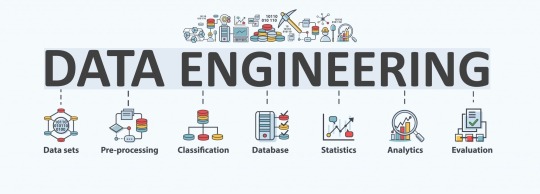
In the era of big data, the ability to design, build, and manage scalable data infrastructure is one of the most in-demand skills in the tech industry. At SEEREE, we are proud to offer a comprehensive Data Engineering course that prepares you for a career at the forefront of data-driven innovation.
Our program covers essential topics such as data modeling, ETL processes, data warehousing, cloud platforms, and tools like Apache Spark, Kafka, and Hadoop. You’ll learn how to collect, organize, and transform raw data into actionable insights, enabling businesses to make smarter decisions.
With real-world projects, expert mentorship, and hands-on experience with the latest technologies, we ensure that you are industry-ready. Whether you’re starting fresh or upskilling, this program will empower you to unlock opportunities in the rapidly growing field of data engineering.
Join SEEREE Institute and take the first step toward building the data pipelines that power tomorrow’s technology!"
Course13:- PGDCA

Seeree offers the best MERN course in Bhubaneswar with 100% job assurance and low fees. Learn from real-time corporate trainers and experienced faculty. Seeree helps students build confidence and gain skills to excel in company roles.
In today’s digital age, computer applications are at the heart of every industry, driving innovation and efficiency. At SEEREE Institute, our Post Graduate Diploma in Computer Applications (PGDCA) program is designed to provide you with in-depth knowledge and hands-on skills to excel in the IT world.
This program offers a comprehensive curriculum covering programming languages, database management, web development, software engineering, networking, and more. Whether you aim to enhance your technical expertise or step into a rewarding career in IT, PGDCA at SEEREE equips you with the tools to succeed.
With expert faculty, state-of-the-art labs, and real-world projects, we ensure that you gain practical experience and a strong theoretical foundation. By the end of the program, you’ll be prepared for roles such as software developer, system analyst, IT manager, or database administrator.
Course14:- Tally

Seeree offers the best Tally course in Bhubaneswar with 100% job assurance and low fees. Learn from real-time corporate trainers and experienced faculty. Seeree helps students build confidence and gain skills to excel in company roles.
In today’s business world, efficient financial management is key to success, and Tally is one of the most trusted tools for accounting and financial operations. At SEEREE Institute, we offer a comprehensive Tally course designed to equip you with the skills needed to manage business finances effortlessly.
Our program covers everything from the basics of accounting and bookkeeping to advanced features like GST compliance, inventory management, payroll processing, and generating financial reports. With hands-on training and real-world applications, you’ll gain practical expertise in using Tally effectively for businesses of any scale.
Whether you're a student, a professional, or a business owner, our Tally program is tailored to meet your needs and enhance your career prospects in the fields of accounting and finance.
Course15:- Graphics Design

In the world of creativity and communication, graphic design plays a vital role in bringing ideas to life. At SEEREE Institute, our Graphic Design course is tailored to help you unlock your creative potential and master the art of visual storytelling.
Our program covers a wide range of topics, including design principles, color theory, typography, branding, and user interface design. You’ll gain hands-on experience with industry-standard tools like Adobe Photoshop, Illustrator, and InDesign, enabling you to create stunning visuals for print, digital media, and beyond.
Whether you're an aspiring designer or a professional looking to sharpen your skills, our expert trainers and real-world projects will provide you with the knowledge and confidence to excel in this competitive field.
Join SEEREE Institute and start your journey toward becoming a skilled graphic designer. Let’s design your future together!"
2 notes
·
View notes
Text
Good Code is Boring
Daily Blogs 358 - Oct 28th, 12.024
Something I started to notice and think about, is how much most good code is kinda boring.
Clever Code
Go (or "Golang" for SEO friendliness) is my third or fourth programming language that I learned, and it is somewhat a new paradigm for me.
My first language was Java, famous for its Object-Oriented Programming (OOP) paradigms and features. I learned it for game development, which is somewhat okay with Java, and to be honest, I hardly remember how it was. However, I learned from others how much OOP can get out of control and be a nightmare with inheritance inside inheritance inside inheritance.
And then I learned JavaScript after some years... fucking god. But being honest, in the start JS was a blast, and I still think it is a good language... for the browser. If you start to go outside from the standard vanilla JavaScript, things start to be clever. In an engineering view, the ecosystem is really powerful, things such as JSX and all the frameworks that use it, the compilers for Vue and Svelte, and the whole bundling, and splitting, and transpiling of Rollup, ESBuild, Vite and using TypeScript, to compile a language to another, that will have a build process, all of this, for an interpreted language... it is a marvel of engineering, but it is just too much.
Finally, I learned Rust... which I kinda like it. I didn't really make a big project with it, just a small CLI for manipulating markdown, which was nice and when I found a good solution for converting Markdown AST to NPF it was a big hit of dopamine because it was really elegant. However, nowadays, I do feel like it is having the same problems of JavaScript. Macros are a good feature, but end up being the go-to solution when you simply can't make the code "look pretty"; or having to use a library to anything a little more complex; or having to deal with lifetimes. And if you want to do anything a little more complex "the Rust way", you will easily do head to head with a wall of skill-issues. I still love it and its complexity, and for things like compiler and transpilers it feels like a good shot.
Going Go
This year I started to learn Go (or "Golang" for SEO friendliness), and it has being kinda awesome.
Go is kinda like Python in its learning curve, and it is somewhat like C but without all the needing of handling memory and needing to create complex data structured from scratch. And I have never really loved it, but never really hated it, since it is mostly just boring and simple.
There are no macros or magic syntax. No pattern matching on types, since you can just use a switch statement. You don't have to worry a lot about packages, since the standard library will cover you up to 80% of features. If you need a package, you don't need to worry about a centralized registry to upload and the security vulnerability of a single failure point, all packages are just Git repositories that you import and that's it. And no file management, since it just uses the file system for packages and imports.
And it feels like Go pretty much made all the obvious decisions that make sense, and you mostly never question or care about them, because they don't annoy you. The syntax doesn't get into your way. And in the end you just end up comparing to other languages' features, saying to yourself "man... we could save some lines here" knowing damn well it's not worth it. It's boring.
You write code, make your feature be completed in some hours, and compile it with go build. And run the binary, and it's fast.
Going Simple
And writing Go kinda opened a new passion in programming for me.
Coming from JavaScript and Rust really made me be costumed with complexity, and going now to Go really is making me value simplicity and having the less moving parts are possible.
I am becoming more aware from installing dependencies, checking to see their dependencies, to be sure that I'm not putting 100 projects under my own. And when I need something more complex but specific, just copy-and-paste it and put the proper license and notice of it, no need to install a whole project. All other necessities I just write my own version, since most of the time it can be simpler, a learning opportunity, and a better solution for your specific problem. With Go I just need go build to build my project, and when I need JavaScript, I just fucking write it and that's it, no TypeScript (JSDoc covers 99% of the use cases for TS), just write JS for the browser, check if what you're using is supported by modern browsers, and serve them as-is.
Doing this is really opening some opportunities to learn how to implement solutions, instead of just using libraries or cumbersome language features to implement it, since I mostly read from source-code of said libraries and implement the concept myself. Not only this, but this is really making me appreciate more standards and tooling, both from languages and from ecosystem (such as web standards), since I can just follow them and have things work easily with the outside world.
The evolution
And I kinda already feel like this is making me a better developer overhaul. I knew that with an interesting experiment I made.
One of my first actual projects was, of course, a to-do app. I wrote it in Vue using Nuxt, and it was great not-gonna-lie, Nuxt and Vue are awesome frameworks and still one of my favorites, but damn well it was overkill for a to-do app. Looking back... more than 30k lines of code for this app is just too much.
And that's what I thought around the start of this year, which is why I made an experiment, creating a to-do app in just one HTML file, using AlpineJS and PicoCSS.
The file ended up having just 350 files.
Today's artists & creative things Music: Torna a casa - by Måneskin
© 2024 Gustavo "Guz" L. de Mello. Licensed under CC BY-SA 4.0
4 notes
·
View notes
Text
Mastering Java: Your Comprehensive Guide to Programming Excellence
Embarking on the journey of mastering Java is akin to entering a realm of endless possibilities. Java, a versatile and widely-utilized programming language, offers a broad spectrum of applications, from crafting web and mobile applications to powering robust enterprise systems. Whether you are a novice in the realm of coding or a seasoned programmer looking to broaden your skill set, the path to proficiency in Java is an exciting one.

In this comprehensive guide, we will be your guiding light through the intricacies of Java, starting from the foundational basics and progressing to the more advanced aspects of the language. Our objective is to equip you with the knowledge and skills that form a robust and unshakable foundation for your journey into the vibrant world of Java. Fasten your seatbelt as we embark on this exhilarating exploration, charting a course that will empower you to thrive in the ever-evolving landscape of software development.
Here's a 8-step guide to effectively learn Java
Step 1: Setting Up Your Development Environment
Your journey to becoming a proficient Java developer commences with setting up your development environment. The essential components are the Java Development Kit (JDK) and an Integrated Development Environment (IDE) like Eclipse or IntelliJ IDEA. These tools aren't just convenient; they're the gears that will drive your Java programming endeavors. They streamline the coding process, provide useful features, and offer an organized workspace, making your coding experience efficient and enjoyable.
Step 2: The Foundation - Learning the Basics
With your development environment ready, it's time to delve into the fundamental building blocks of Java. Begin by acquainting yourself with data types, variables, operators, and control structures. These are the nuts and bolts of the language, and a solid grasp of these concepts is essential. You'll find an abundance of online tutorials and beginner-friendly Java books to assist you at this stage.
Step 3: Navigating the World of Object-Oriented Programming (OOP)
The object-oriented programming (OOP) approach is well known in Java. To harness the true power of Java, immerse yourself in the world of OOP. Understand the concepts of classes, objects, inheritance, encapsulation, and polymorphism. This knowledge forms the bedrock of Java programming and enables you to design efficient, organized, and scalable code.
Step 4: Mastering Data Structures and Algorithms
Data structures (such as arrays, lists, and sets) and algorithms are the secret sauce behind solving real-world problems efficiently. As you progress, dive into the world of data structures and algorithms. These are the tools that will empower you to handle complex tasks and optimize your code. They're your go-to assets for creating efficient and responsive applications.
Step 5: The Art of Exception Handling
Java boasts a robust exception-handling mechanism. Understanding how to handle exceptions properly is not just an add-on skill; it's a vital aspect of writing reliable code. Exception handling ensures that your code gracefully manages unexpected situations, preventing crashes and delivering a seamless user experience.
Step 6: Exploring Input and Output Operations
In this step, you'll explore the realm of input and output (I/O) operations. Mastering I/O is crucial for reading and writing files, as well as interacting with users. You'll gain the ability to build applications that can efficiently process data and communicate effectively with users.
Step 7: Conquering Multi tasking
Java's support for multi tasking is a significant advantage. Understanding how to manage threads and synchronize their actions is vital for creating concurrent applications. Multithreading is the key to developing software that can handle multiple tasks simultaneously, making your applications responsive and scalable.
Step 8: Building Projects and Real-World Practice
Theory is only as valuable as its practical application. The final step involves applying what you've learned by building small projects. These projects serve as a proving ground for your skills and provide valuable additions to your portfolio. Whether it's a simple application or a more complex project, the act of building is where the real learning takes place.

As you step into this vibrant realm of Java, remember that continuous learning is the key to staying relevant and effective in the ever-evolving field of software development. Be open to exploring diverse applications, from web development to mobile apps and enterprise solutions, and never underestimate the power of hands-on practice. Building projects, no matter how small, will solidify your knowledge and boost your confidence.
In your quest to master Java, ACTE Technologies stands as a valuable ally. Their expert guidance and comprehensive training programs will sharpen your skills, boost your confidence, and pave the way for a rewarding career in software development. Whether you're embarking on your Java journey or looking to take your skills to the next level, ACTE Technologies offers the resources and support you need to thrive in the world of Java programming.
So, with Java as your trusty companion, and ACTE Technologies as your guide, the possibilities are boundless. Your journey is just beginning, and the world of software development awaits your innovation and expertise. Best of luck on your path to mastering Java!
9 notes
·
View notes
Text
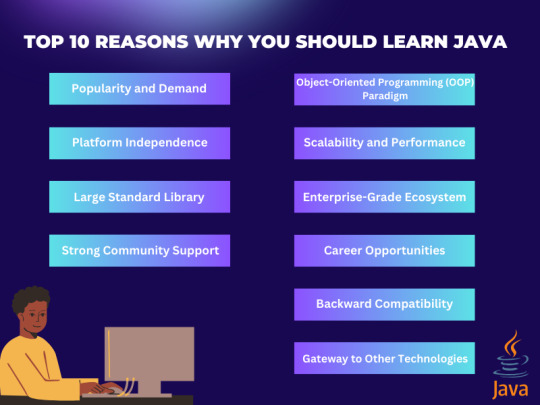
Top 10 Reasons Why You Should Learn Java Java is one of the most widely used programming languages in the world, known for its versatility and robustness. Java provides various features Have look at the top 10 reasons why you should learn Java: Popularity and Demand Platform Independence Large Standard Library Strong Community Support Object-Oriented Programming (OOP) Paradigm Scalability and Performance Enterprise-Grade Ecosystem Career Opportunities Backward Compatibility Gateway to Other Technologies
#besttraininginstitute#onlinetraining#traininginstitute#online#training#education#database#tutorial#coding#programming#java#top10#ten#topten#top#trend#trending#technology#educationplatform
2 notes
·
View notes
Text
Master Java Programming with Techmindz: The Best Java Programming Course in Kochi
In the digital age, Java remains one of the most popular and in-demand programming languages in the world. Whether you're aspiring to become a software developer, backend engineer, or mobile application creator, mastering Java can open the doors to countless career opportunities. If you're looking for a high-quality Java Programming Course in Kochi, Techmindz offers a comprehensive training program designed to take you from beginner to professional.
Why Learn Java?
Java is a versatile, object-oriented programming language that powers everything from enterprise-level applications to Android apps. It offers platform independence, robust security features, and a massive global developer community. Here are some reasons why learning Java is a smart investment in your career:
High Demand for Java Developers
Platform Independence (Write Once, Run Anywhere)
Strong Community Support and Libraries
Great for Backend, Web, and Android Development
Why Choose Techmindz for Java Training in Kochi?
Techmindz, based in Infopark Kochi, is a leading IT training provider known for bridging the gap between academic learning and industry demands. Our Java Programming Course in Kochi is designed by industry experts to ensure practical exposure, hands-on learning, and real-world application.
Key Features of Our Java Course:
Industry-Oriented Curriculum Our course covers core Java, object-oriented programming, JDBC, servlets, JSP, frameworks like Spring and Hibernate, and even introductory Android development.
Hands-On Projects Students work on live projects that simulate real-world business challenges, ensuring they are job-ready from day one.
Experienced Trainers Learn from Java professionals with years of industry experience and teaching expertise.
Internship and Placement Support We provide internship opportunities and have tie-ups with IT companies in Kochi and beyond, helping you land your dream job.
Flexible Learning Options We offer both weekday and weekend batches, online and offline classes, to suit the needs of students and working professionals alike.
Who Should Enroll?
Fresh Graduates looking to start a career in software development
Working Professionals aiming to upskill or switch to Java-based roles
Entrepreneurs & Freelancers who want to build their own Java-based applications
Course Modules Include:
Introduction to Java & IDE setup
Object-Oriented Programming (OOP) concepts
Exception Handling, Multithreading, Collections
JDBC and Database Connectivity
Web Application Development with Servlets and JSP
Spring Framework and Hibernate ORM
Mini and Major Projects
Resume Building and Mock Interviews
Enroll Now – Build Your Future in Java Programming
Don’t miss your chance to learn from the best. With its industry-focused curriculum, expert faculty, and proven placement support, Techmindz is your go-to destination for a Java Programming Course in Kochi.
https://www.techmindz.com/java-programming-course-kochi-infopark/
0 notes
Text
Inheritance in Java – Explained with Examples
Understand Inheritance in Java with this clear and concise guide from Scientech Easy. Learn how Java inheritance promotes code reusability, supports hierarchical classification, and forms the backbone of object-oriented programming. This article covers types of inheritance, syntax, real-life examples, and common use cases to make learning easy for beginners and intermediates. Scientech Easy to boost your Java knowledge and get practical insights into core OOP principles. Start mastering inheritance in Java today with confidence!
0 notes
Text
These are the 10 most important Java features every developer should be aware of
Start Your Java Journey Right
If you’re searching for the best Java training in Hyderabad, understanding the core features of Java is essential. Java remains one of the most popular programming languages in the world, thanks to its platform independence, security, and scalability. Whether you're a beginner or an experienced developer, mastering its key features is crucial for building efficient and robust applications.
1. Platform Independence
Java’s “Write Once, Run Anywhere” principle allows code to run on any device with a Java Virtual Machine (JVM), making it highly portable.
2. Object-Oriented Programming (OOP)
Java follows OOP principles like inheritance, encapsulation, polymorphism, and abstraction, which help organize and structure code efficiently.
3. Robust and Secure
Java provides strong memory management, exception handling, and a secure runtime environment that minimizes vulnerabilities.
4. Automatic Garbage Collection
Java handles memory management automatically through garbage collection, reducing memory leaks and improving performance.
5. Multithreading
Java supports multithreaded programming, enabling developers to write highly responsive and interactive applications.
6. Rich API
Java offers a comprehensive set of APIs for everything from networking to data structures, simplifying development.
7. High Performance
Thanks to Just-In-Time (JIT) compilers and optimized bytecode, Java delivers impressive performance for both desktop and web applications.
8. Dynamic and Extensible
Java supports dynamic loading of classes and is designed to adapt to evolving development needs.
9. Community Support
For developers, a vast global community ensures constant updates, libraries, and frameworks.
10. Backward Compatibility
Java maintains compatibility with older versions, ensuring that legacy applications remain functional.
Conclusion
To master these features and more, expert guidance makes all the difference. Enroll in SSSIT Computer Education for practical, industry-oriented Java training that will take your coding skills to the next level.
#best java training in hyderabad#best java training in kphb#best java training in kukatpally#best software training institute in hyderabad
0 notes
Text
Java: the name conjures images of bustling virtual worlds, robust enterprise systems, and perhaps, a steaming mug of coffee. But behind the ubiquitous language lies a surprisingly rich and often overlooked history. Prepare to journey through time with this listicle, exploring seven fascinating fun facts and surprising milestones in the evolution of Java.From its humble beginnings as "Oak" to its current reign as a programming powerhouse, discover unexpected twists, pivotal moments, and the sheer ingenuity that shaped this iconic language. By the end, you’ll not only know more about Java’s development than your average coder, but you'll also gain a deeper thankfulness for the enduring legacy of this technological giant. 1) From Oak to java: The name change wasn't just a rebranding; it reflected a shift in focus from cable box programming to the burgeoning internet Initially christened "Oak," the language's early days were deeply intertwined with the then-dominant world of interactive television. Imagine a time before streaming, before even widespread broadband! Oak was designed to power interactive features on cable boxes – a far cry from its eventual dominance in web applications and enterprise software. This initial vision, while enterprising for its time, ultimately proved too niche. The burgeoning internet,with its explosive potential,was calling for a different kind of programming language.The shift to "Java" wasn't��� purely cosmetic. It signified a strategic pivot, a bold recognition that the future lay in the interconnectedness of the world Wide Web. The name change reflected this new reality, and more importantly, the platform's inherent adaptability to this burgeoning digital landscape. What were some of the crucial elements of this shift? Platform Independence: "Write once,run anywhere" became the mantra,freeing Java from the limitations of specific operating systems. Object-Oriented Programming (OOP): A paradigm shift emphasizing modularity and reusability, key to scaling for internet applications. Community Growth: The open-source nature of Java fostered a massive and collaborative developer community. This wasn't just a name change, it was a complete paradigm shift mirroring the digital revolution itself. Before After cable box programming web applications & Enterprise Software Oak Java Limited reach Global dominance 2) The Green Book: The original Java documentation, famously nicknamed "The Green Book," was a crucial resource in the early days, providing a crucial foundation for developers tackling this new language Before the readily-available online documentation we take for granted today, Java developers relied on a physical tome: a hefty, green-covered manual affectionately known as "The Green Book." this wasn't just any manual; it was the definitive guide,a treasure trove of facts for those navigating the then-uncharted waters of Java programming.Imagine wrestling with complex code, with only this physical book to guide you – no Stack Overflow, no instant online searches! It fostered a unique sense of community, with developers sharing their Green Book-honed wisdom and annotations in a pre-internet collaborative spirit.Think of it as the ultimate "learn-to-code" survival kit, packed with the most crucial insights and examples. It wasn't just a reference; it was a learning companion. The very act of flipping through its pages, underlining key concepts, and scribbling notes in the margins became a ritual, forging a deep connection between developer and technology. what kind of information did you find in it? core Java Concepts: Essential building blocks and data structures API references: Essential classes and methods for everyday tasks Example Code Snippets: Practical implementations to learn from It truly laid the groundwork for a generation of Java gurus. Green Book Era Modern Java Physical Manual
Online Documentation Shared Annotations collaborative Online Forums Limited Updates Continuous Updates 3) The Rise of the JVM: The Java Virtual Machine's cross-platform capability was a game-changer,unlocking Java's potential for widespread adoption across diverse operating systems Before the magic of the JVM,writing code meant wrestling with the specific quirks of each operating system.Imagine needing a separate version of your software for Windows,macOS,Linux,and every flavor of unix – a developer's nightmare! But then came the Java Virtual Machine,a brilliant layer of abstraction that allowed Java code to run anywhere,irrespective of the underlying platform. This "write once, run anywhere" (WORA) concept wasn't just a catchy slogan; it was a fundamental shift in how software was built and deployed. It was the key that unlocked Java's potential to become the ubiquitous language it is indeed today.This cross-platform capability wasn't just convenient; it was revolutionary. It democratized software development, enabling a wider range of developers to contribute and fostering a diverse ecosystem of libraries and frameworks. Think about it: this single innovation allowed Java to flourish on everything from supercomputers to tiny embedded systems. The impact is staggering. Consider this fast comparison: Before JVM After JVM Code for each OS Write Once, Run Anywhere Limited reach Global reach High development cost Lower development cost 4) Applet Mania: Remember those tiny Java animations that used to adorn websites in the late 90s? They were a defining feature of the early internet experience Before the reign of flashy websites brimming with JavaScript magic, a simpler, yet equally captivating form of interactive content held sway. Remember those miniature worlds, often featuring bouncing balls, swirling galaxies, or even rudimentary games, that would greet you on countless websites? These weren't mere GIFs; they were Java applets, tiny programs that added a touch of animated flair to the otherwise static landscape of the early web. They were the charming digital postcards of their time, a quirky testament to the nascent possibilities of the internet. Think of the excitement of seeing a fully rendered 3D model of a molecule spinning patiently on a scientific website or a simple, color-changing clock adding visual interest to a basic webpage, thanks to Java's magic.Their simplicity belied a surprising level of technological achievement for the era. these tiny programs, frequently enough downloaded and executed directly within the user's browser, represented a meaningful leap in the interactivity of web pages.While seemingly rudimentary by today's standards, their impact was profound. They were a key part of the learning curve for developers and users alike, setting the stage for future advancements in web development. The legacy of applets lives on less directly, reminding us that innovation frequently stems from the seemingly simple. Applet Type Common Feature Nostalgia Level Spinning 3D Objects Rotation Animation High Bouncing Balls Simple Physics Medium Digital Clocks Time Display Low 5) Java's Enterprise Journey: The emergence of Java Enterprise Edition (JEE) marked a significant shift towards server-side development, fueling the growth of large-scale applications Before the arrival of Java Enterprise Edition (JEE), building robust, scalable applications was a Herculean task. Imagine crafting sprawling, multi-tiered systems with inconsistent tools and a lack of standardized frameworks. JEE changed everything. It introduced a comprehensive set of APIs and services, providing developers with a standardized, streamlined��� approach to handle everything from database interaction to complex transaction management. This paved the way for the development of enterprise-grade applications able to handle millions of users and massive amounts of data, forming the backbone of countless businesses and systems we rely on every day.
The "enterprise" part wasn't just a label; it signified a paradigm shift in how software was conceived, built, and deployed.The impact was transformative.Consider these innovations brought about by JEE's emergence: Component-based architecture: Building applications from reusable, modular components boosted developer efficiency and maintainability. Simplified transaction management: Ensuring data consistency across distributed systems became significantly easier. Standardized security features: Secured applications became the norm, rather than an optional extra. Benefit Impact Simplified Development Faster development cycles Improved Scalability Handling of high user loads Enhanced Security Reduced vulnerabilities 6) Generics Arrive: The introduction of generics in Java 5 was a major step towards improving type safety and reducing runtime errors Before Java 5, dealing with collections was a bit like a wild west showdown. You'd throw objects into an ArrayList, hoping for the best, and then at runtime… *bam*! A ClassCastException. the introduction of generics brought order to the chaos. Imagine a meticulously organized saloon, where every bottle (object) is clearly labeled with its type (e.g., ArrayList, ArrayList). The compiler became your trusty sheriff, preventing type mismatches before they could cause trouble. This meant fewer runtime surprises and more robust code.The impact was dramatic. Suddenly, developers could write cleaner, more maintainable code. No more casting! No more runtime exceptions springing from type confusion! And the best part? The compiler was there to offer helpful warnings and prevent potential problems. This shift towards compile-time type safety improved productivity and reduced debugging time significantly. Consider the following: Before Generics after Generics Lots of casting ((String) myList.get(0)) Direct access (myList.get(0)) Increased risk of runtime errors Improved type safety More debugging time Less debugging time here are some key benefits you really should know about: Enhanced Type Safety: the compiler enforces type constraints during compilation. Improved Code Readability: Code becomes more self-documenting and easier to understand. Reduced Runtime Errors: Fewer ClassCastException errors mean fewer headaches. Increased Productivity: Developers spend less time debugging and fixing type-related issues. 7) Lambdas and Streams: Java 8's embrace of functional programming paradigms, with features like lambdas and streams, modernized the language and improved developer productivity Before Java 8, writing concise, elegant code for tasks involving collections felt like navigating a labyrinth. Suddenly, Project Lambda burst onto the scene, injecting a potent dose of functional programming directly into the Java vein. Lambdas, those elegant little anonymous functions, streamlined code significantly.Imagine transforming a list of numbers – previously a multi-line affair – into a single, expressive line. The impact was transformative: less boilerplate, clearer intent, and a significant boost in developer happiness. No more verbose anonymous inner classes! This wasn't just syntactic sugar; it was a paradigm shift.And then there were Streams. These weren't just your typical Java streams; they were declarative powerhouses, allowing developers to express complex operations on collections with remarkable clarity. Filtering, mapping, reducing – all became incredibly intuitive. Suddenly, operations previously requiring intricate loops could be expressed in a chain of easily understandable methods. The result? Code that was not only more readable but also often more efficient. Here's a glimpse of that transformation: Before Java 8 Java 8 (Streams) lengthy loops and iterations Elegant method chaining Difficult to read and maintain Improved readability and maintainability Potential for inefficiency
Often more performant Improved Conciseness: Less code, more impact! Enhanced Readability: Code that's easier to understand and maintain. Increased Efficiency: Streams often lead to optimized performance. 8) Modular Java: Project Jigsaw's introduction of the Java platform Module System (JPMS) aimed to improve the scalability and maintainability of complex Java applications Before Project Jigsaw, managing dependencies in large java projects felt like wrangling a herd of especially unruly cats. Imagine a sprawling codebase where even a minor change could trigger a cascade of unforeseen consequences. Enter JPMS, a game-changer that brought much-needed order to the chaos. Think of it as modularizing your code into neatly packaged units, each with its own clearly defined dependencies. this approach dramatically reduced the risk of accidental changes breaking unrelated parts, making maintenance a far less stressful endeavor. The benefits extended beyond just simplifying updates; it also boosted performance by allowing the Java Virtual Machine (JVM) to load only the necessary modules,avoiding the overhead of loading unused code – like decluttering your digital desktop!The impact of Jigsaw wasn't just about improved scalability and maintainability; it also fundamentally shifted how Java developers approached project architecture. It encouraged a more thoughtful, structured design process, promoting code reuse and better collaboration. The ability to clearly define module boundaries fostered a clearer understanding of the system, making it easier to onboard new team members and to keep track of changes. Imagine this: Before Jigsaw After Jigsaw Dependency hell Organized modules Slow build times Faster build times Difficult maintenance Easier maintenance This shift in mindset wasn’t just about technical improvements; it represented a significant step towards a more sustainable and robust approach to Java development. 9) GraalVM: This advanced runtime environment extends Java's capabilities with native image compilation, boosting performance and potentially enabling new deployment strategies Forget slow and steady; GraalVM injects a shot of adrenaline into the Java ecosystem. this isn't your grandpappy's Java Virtual Machine. By ���employing native image compilation, GraalVM transforms Java code into native executables, bypassing the JVM's runtime overhead. the result? Applications that launch faster, consume less memory, and boast significantly improved performance. Imagine serverless functions or microservices springing to life in a blink – that’s the power of graalvm in action. Benefit Impact Faster Startup Times Improved User Experience Reduced Memory Footprint efficient Resource Utilization Enhanced Security Less Attack Surface Improved Deployment Adaptability: Explore new deployment environments previously inaccessible to customary Java applications. Enhanced Performance Metrics: witness considerable boosts in throughput and response times. Smaller Deployment Packages: Ship leaner applications, leading to faster downloads and reduced storage needs. Future Outlook And there you have it – a whirlwind tour through the surprisingly vibrant history of Java! From its humble beginnings as "Oak" to its current reign as a global programming powerhouse, Java's journey is a testament to both innovative design and unwavering community support. While this list only scratches the surface of its evolution, we hope it's ignited your curiosity about this enduring language. So, the next time you encounter the familiar Java logo, remember the fascinating story behind it – a story still being written, one line of code at a time.
0 notes
Text
Coding Excellence Begins at the Best Java Institute in Laxmi Nagar

If you're aspiring to become a Java developer and looking for the best Java institute in Laxmi Nagar, you're already on the right path. Java remains one of the most powerful, platform-independent programming languages used across the tech industry today. From building mobile applications to enterprise-grade software, Java is everywhere—and mastering it can significantly boost your career prospects.
Laxmi Nagar has emerged as a prime hub for IT and programming education in Delhi. With numerous training centers and coaching institutes, it’s important to choose an institute that not only provides quality education but also offers strong placement support, updated curriculum, and experienced trainers. That’s why finding the best Java institute in Laxmi Nagar can make a substantial difference in how quickly and effectively you become industry-ready.
What Makes an Institute the Best?
When we talk about the best Java institute in Laxmi Nagar, several critical factors come into play. These include:
Qualified and Experienced Trainers: The best institutes hire trainers with real-world industry experience who can provide practical exposure, not just theoretical knowledge.
Updated Curriculum: Java is constantly evolving. A good course includes the latest features like Java 17, Spring Boot, Hibernate, and frameworks commonly used in the industry.
Live Projects and Assignments: Hands-on learning is crucial. Institutes that offer project-based learning give you a better grasp of real-time problem-solving.
Job Assistance and Internships: Placement support, mock interviews, and internship opportunities are essential to transitioning from learner to professional.
Why Laxmi Nagar?
Laxmi Nagar is not just centrally located but also offers access to a large number of affordable and high-quality institutes. Many working professionals and students from Delhi NCR prefer Laxmi Nagar due to its connectivity and resource-rich environment. Whether you're a beginner or someone looking to upgrade your skills, enrolling in the best Java course in Laxmi Nagar can help you stand out in a competitive job market.
Choosing the Right Course
The best Java course in Laxmi Nagar should cover core concepts such as:
Java Syntax and Basics
Object-Oriented Programming (OOP)
Data Structures and Algorithms
JDBC and Database Integration
Servlets and JSP
Spring Framework and Spring Boot
Hibernate ORM
Deployment and Version Control using Git
Final Thoughts
Java is more than just a programming language—it’s a gateway to exciting careers in software development, data analytics, mobile apps, and more. Investing in a comprehensive and well-structured Java course can set the foundation for long-term success. If you're committed to learning and want to ensure you're guided by experts, then enrolling in the best Java institute in Laxmi Nagar is your next step.
Start your journey today with the right training, and you’ll be well on your way to becoming a proficient Java developer.
0 notes
Text
How to Choose the Best Mobile Game Development Company in India

The mobile gaming industry in India has seen rapid growth in recent years, all of this is possible due to the availability of budget-friendly smartphones, affordable internet service, a large gaming audience in India, and many other factors also play an important role. Most of the companies from all over the world and clients are now selecting India-based game development companies for their mobile gaming projects. This article will give you an overview of how to choose an India-based mobile game development company, as well as some information related to games is also discussed below.
Factors Involved in Choosing Mobile Game Development Companies
Various factors were involved in selecting the mobile game development services provider for your projects. Each factor has its importance, and selecting the game development companies based on these factors results in getting high-quality results, and it helps the company to earn a high return on investment. Some of the common points are mentioned below, which will give you a piece of information regarding them.
Define your Requirements: Before choosing any mobile game development companies it is very important to clearly define your requirements, such as deciding what type of game genre you need, and for which platform you need the game. Along with choosing the budget for your game development, how much you are going to invest in developing the game, and setting a deadline for the game development projects.
Experience and Expertise: It is very important to check the experience of game development companies, checking their experience in game development tools, and what kind of games they are developing, checking what kind of services they also provide related to game development, such as 3d mobile game development and many more services. Along with it is important to check the expertise of companies in the latest technology, such as blockchain, AR/VR, Metaverse, and many more technologies.
Checking the Portfolio: It is important to check the portfolio of a mobile game development company, as it gives you an understanding and information regarding what kind of services they have delivered to various clients and industries. As well as giving the information, also what extra features or services they have provided, which make the game unique.
Check Client Reviews: It is very important to check the reviews provided by clients or the industry for mobile game development companies. You can check the testimonials of the companies on various platforms such as Clutch, GMB Reviews, LinkedIn Referrals, and on various platforms. Positive feedback provided by the client helps in building the reputation of the company as well as increasing the trust between the client and the company.
Compare Pricing: It is very important to check the prices offered by the mobile game development services provider. Every game development company offers different prices for developing games to every client. The cost of developing the games depends upon various factors such as the complexity of the game, the resources to be used in the game, technology to be used in the game. And many more factors were also involved which effect the cost of developing the games.
Which Language is used for Mobile Game Development
Various languages were used in developing the mobile games. Every language has its importance, due to which most of the game development companies were using these diffrent languages for developing the games. Some of the commonly used languages are mentioned below.
Java/Kotlin: This language is most commonly used by game development companies while developing Android games. Some of the most important features provided by this language are that once the code is written, it can be run on various platforms, the OOP feature in Java allows the code to be use again.
C++: This language is most commonly used by 3d mobile game development companies. This language provides various benefits such as efficiency, flexibility, and control over hardware and memory.
C: This language is commonly used for developing 2d games, 3d games for the Android and iOS platforms. This language provides various benefits, such as it is easy to write fast and reliable code, code written in C can be easily compiled and it can be easily run on various platforms.
Which is the No. 1 Mobile Game in India?
Ludo King is the most popular game among the Indian gaming audience, This game provides various features such as multiplayer gaming support, live game play, and a free-to-play game feature. Apart from it, various games were also trending in India, such as Free Fire, Candy Crush, Call of Duty, and many more games were trending in India. Due to an increase in competition in the gaming market, most of the game development companies were developing thrilling and engaging games by using the latest technology to ensure smooth game performance, as well as integrating the latest features in the game, which makes games more engaging.
Conclusion
Choosing the best mobile game development company in India requires detailed research about the companies who were available in India and provide services related to game development. As well as various factors such as checking experience, expertise, portfolio, checking testimonials, and many more factors to be considered before selecting any company for game development, this wil benefits in providing high-quality result, as well as helping the company to earn high return on investments by collaborating with India based best game development service provider companies.
0 notes
Text
Understanding OOP Concepts in Java with Real-World Examples
If you're exploring options for java full stack training in Hyderabad, getting comfortable with Object-Oriented Programming (OOP) in Java is a must. OOP is the backbone of Java—it helps make your code cleaner, easier to manage, and perfect for building real-world applications.
Encapsulation – Keeping Things Safe and Simple
Encapsulation is like putting everything related to a task into one box. Imagine a bank account—you can check your balance or deposit money, but you can’t mess with the internal calculations. In Java, this is done using private variables and public methods to control access, keeping your data safe from unexpected changes.
Inheritance – Building on What You Already Have
Think about a basic Vehicle class with properties like speed and fuel. Now, instead of writing that all over again, you create a Car or Bike class that inherits those traits and adds its own flavor. That’s inheritance in Java—reuse what works, and build new features on top.
Polymorphism – One Action, Many Behaviors
Different actions can be performed by the same action according to polymorphism. A method like draw() could draw a circle, square, or triangle depending on the object. It’s like how “play” means something different depending on whether you're playing a song or a sport. This maintains the flexibility and power of Java code.
Abstraction – Only Show What’s Needed
You use a phone every day without knowing how the circuits inside work, right? That’s abstraction. Java lets you create interfaces and abstract classes to hide complex logic and just focus on what the program needs to do.
Conclusion
Learning OOP is a huge step toward becoming a confident Java developer. If you're serious about it, Monopoly IT Solutions offers hands-on training that brings these concepts to life through real-world projects and expert guidance
0 notes
Text
Mastering the Basics of Java: Your Gateway to Software Development
In the ever-evolving landscape of programming, Java stands as a versatile and widely-adopted language that has consistently been the preferred choice of developers worldwide. Whether you are a newcomer taking your first steps into the world of programming or an experienced developer seeking to broaden your skillset, acquiring a profound understanding of Java's fundamentals is an essential stride forward. In this comprehensive and meticulously crafted guide, we embark on a journey to delve deep into the core concepts of Java programming. This knowledge will not only serve as a strong foundation but also empower you to navigate the dynamic and ever-evolving domain of software development with confidence.
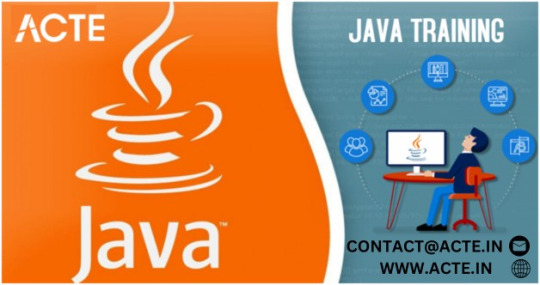
Java's popularity has endured for decades, and it shows no signs of slowing down. Its ability to adapt to the ever-shifting demands of the software industry, coupled with its cross-platform compatibility, has made it a mainstay for both beginners and seasoned professionals. Whether you aspire to develop web applications, mobile apps, or enterprise-grade software solutions, Java offers a versatile platform to turn your coding dreams into reality.
1. Syntax: The Building Blocks of Java
Java's syntax is often praised for its readability and similarity to other programming languages like C++ and C#. This makes it relatively easy to learn, especially if you have experience with these languages. The key feature of Java's syntax is the use of curly braces {} to define blocks of code. These braces play a fundamental role in structuring Java programs, making it essential to grasp their usage.
2. Objects and Classes: Embracing Object-Oriented Programming (OOP)
Java is an object-oriented programming (OOP) language, which means it revolves around the concepts of objects and classes. In Java, everything is treated as an object, and classes serve as blueprints for creating these objects. A class defines both the properties (fields) and behaviors (methods) of an object. Understanding the principles of OOP is vital for building well-structured and modular Java applications.
3. Data Types: The Foundation of Variables and Data Manipulation
Java supports a variety of data types, categorized into primitive data types (e.g., int, double, char) and reference data types (e.g., objects, arrays). Primitive data types represent basic values, while reference data types refer to objects created from classes. Grasping these data types is essential for declaring variables and manipulating data in your Java programs.
4. Control Flow: Directing the Flow of Your Program
Java provides an array of control flow statements that dictate the execution flow of your program. These include conditional statements (such as if-else and switch), looping statements (including for, while, and do-while), and branching statements (like break, continue, and return). Mastery of these control flow structures is crucial for creating efficient and logic-driven Java applications.
5. Inheritance: Building on Existing Foundations
Inheritance is a core concept in Java that enables you to create new classes based on existing ones. By inheriting the properties and behaviors of a parent class, you can promote code reusability and establish a more organized code structure. Inheritance is a powerful tool for designing extensible and scalable Java applications.
6. Polymorphism: Achieving Flexibility and Extensibility
Polymorphism is another hallmark of Java's object-oriented approach. It enables objects of various classes to be handled as though they were members of a single superclass. This flexibility in code design allows you to create more versatile and extensible applications. Understanding polymorphism is essential for leveraging the full potential of Java's object-oriented capabilities.
7. Exception Handling: Managing Errors Gracefully
Java boasts a robust exception-handling mechanism to deal with runtime errors. By using try-catch blocks, you can gracefully handle exceptions, ensuring that your program doesn't crash unexpectedly. Effective exception handling is a key aspect of writing robust and reliable Java code.
8. Packages and Libraries: Harnessing the Power of Java's Ecosystem
Java offers a vast standard library known as the Java Standard Library or Java API. Additionally, it allows you to organize your code into packages for better organization and modularity. Leveraging these packages and libraries is essential for streamlining your development process and tapping into a wealth of pre-built functionality.
9. Memory Management: The Art of Garbage Collection
Java employs a unique feature called garbage collection to automatically manage memory. This process helps prevent memory leaks and ensures efficient memory usage in your Java applications. Understanding how garbage collection works is crucial for maintaining the performance and stability of your programs.
10. Multithreading: Building Responsive and Scalable Applications
Java's support for multithreading allows you to execute multiple threads concurrently. Threads are smaller units of a process that can run independently, making it possible to build responsive and scalable applications. Mastering multithreading is essential for developing high-performance Java software, particularly in today's world of parallel computing.
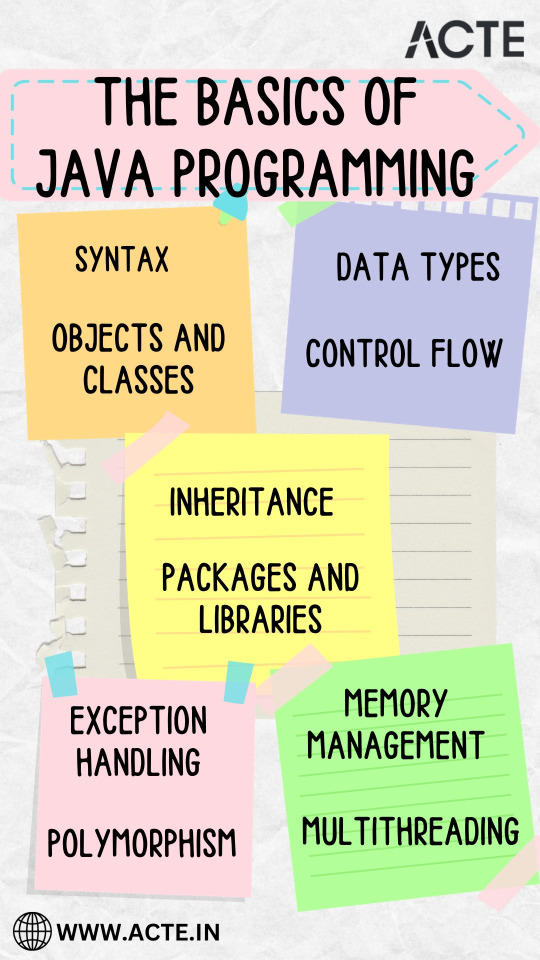
Learning Java opens doors to a wide range of career opportunities in software development and information technology. Whether you're interested in building web applications, mobile apps, or enterprise solutions, Java's versatility makes it a valuable skill.
If you're looking to embark on your Java programming journey or enhance your existing skills, consider exploring courses and training programs offered by reputable institutions like ACTE Technologies. They provide comprehensive learning experiences and expert guidance to help you master Java and advance your career in this exciting field.
In conclusion, Java's robust features and wide-ranging applications make it a compelling choice for developers worldwide. By mastering its fundamental concepts and continuously expanding your knowledge, you'll be well-prepared to tackle complex projects and contribute to the ever-evolving world of software development. Good luck with your Java programming efforts!
8 notes
·
View notes